
Kente is a ceremonial cloth hand- woven on a horizontal treadle loom, kente comes in strips measuring about 4 inches wide and sown together into larger pieces of cloth. It comes in variety of colours and different designs. The word “Kente” comes from the word “kenten”, which means basket.
Kente Royal Cloth are very important for its rich colours and meaningful designs. Infact the premisence of the Asante Monarchy is interfered with the Kente cloth. The Kente weaver gives each piece of cloth philosophical, historical and divine name.
Kente Royal Cloth are very important for its rich colours and meaningful designs. Infact the premisence of the Asante Monarchy is interfered with the Kente cloth. The Kente weaver gives each piece of cloth philosophical, historical and divine name. Kente is more than a clothing item, it is a visual representation of history philosophy, ethics, oral literature religious beliefs and political thought.
According to tradition kente is reserved for special occasion, it is not meant to be used for common place or daily activities or an ordinary wear. It can also be used as special gift item or clothing item used for rites of passage such a child naming, puberty rites invitations, graduations, marriage ceremony, soul washing, burial and ancestral remembrance ceremonies. Kente is used not only for its beauty but also for its symbolic significance.
Each of the cloth has a name and a meaning, names and meanings are derived from historical events, individual achievements, proverbs, philosophical concepts, oral literature, moral values, social code of conduct, human behaviour, and certain attributes of plant and animals life.
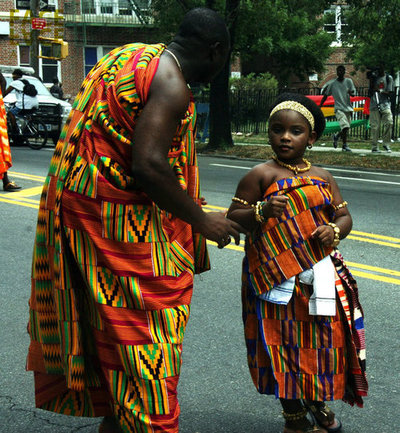
Kente has achieved a tremendous international recognition and has become one of the tangible manifestations of an ever-growing sense of Pan Africanizm. Kente is more widely recognized as one of the shinning strands which make up the colourful cultural fabric of our global village.
The origin of Kente cloth is explained partly with a legend and partly with historical account, coming from two important towns in Asante Region of Ghana, namely Bonwire and Adawomase.
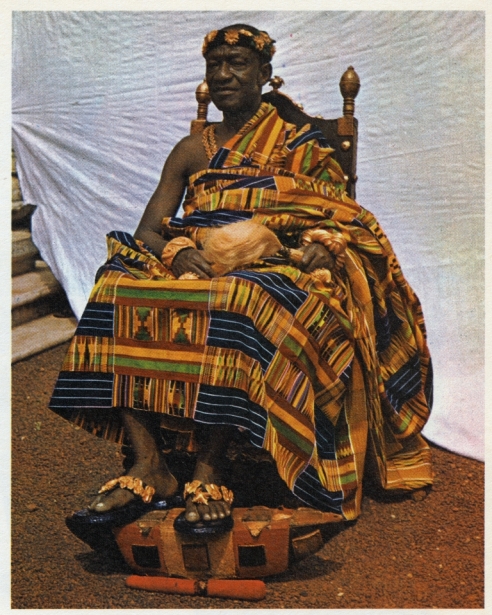
History
Although Kente dresses, as we know it was developed in the 17th Century A.D. by the Ashanti people, it has it roots in a long tradition of weaving in Africa dating back to about 3000 B.C. The origin of Kente is explained with both a legend and historical accounts. A legend has it that a man named Ota Karaban and his friend Kwaku Ameyaw from the town of Bonwire (now the leading Kente weaving center in Ashanti), learned the art of weaving by observing a spider weaving its web.
Taking a cue from the spider, they wove a strip of raffia fabric and later improved upon their skill. They reported their discovery to their chief Nana Bobie, who in turn reported it to the Asantehene (The Ashanti Chief) at that time. The Asantehene adopted it as a royal cloth and encouraged its development as a cloth of prestige reserved for special occasions.
On the part of Adawomase’s historical art of weaving, it traces it source from the north Ouagadougou (now Burkina Faso) with the help of two citizens from Adawomase, namely Nana Sarkodie and Nana Amankwa. They discovered this brand of weaving technique on their usual trade mission to the north of Ouagadougou around the year 1750.
Nana Sarkodie being a good trader and a prince, decided to go back to Ouagadougou with his friend Nana Amankwa. They stayed there as long as they could and learnt the art of weaving. After staying there for so many years they returned to Adawomase with the discovery which they brought with them a piece of woven cloth which they named it “Fufutoma” the white cloth. As a result of this valuable achievement by the two sons of Adawomase, a special stool Fufutoma was created by Asantehene to signify the origin of Fufutoma designs. All occupants of the stool have special duties to perform at the Asantehene’s palace.
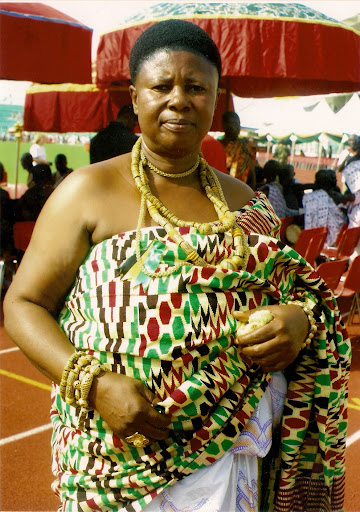
Historical accounts trace the origin of Kente weaving to early weaving traditions in ancient West African Kingdoms that flourished between 300 A.D. and 1600 A.D. Some historians maintain that Kente is an outgrowth of various weaving traditions that existed in West Africa prior to the formation of the Ashanti Kingdom in the 17th Century.

Archaeological research has dated examples of narrow- strip cloths woven in West Africa as early as the 11th Century A.D. and perhaps earlier. Some examples of woven fabrics have been found in the caves of the Bandiagara cliffs in Mali.
These cloths used in burial ceremonies, probably, during the medieval Ghana, Mali and Soghai Empires, have technical and aesthetic features similar to many of the narrow-strip cloths in many parts of West Africa.
ALSO SEE: Abaji Nupe Community Mark As Nupe Cultural Day
Such cloths which the Akans call “Nsaa” are important components of scared royal paraphernalia in most Akan royal courts today and are know to have been traded with articles of prestige by Akan Kings and chiefs early in the 17th Century. Many features of such cloths appear in the early and later narrow-strip cloths woven in Ashanti.
Given these historical accounts, it is believed that the Ashanti craftsmen might have learned weaving skills from other peoples living North and West of them and later developed their unique style of cloth.
While Kente Cloth may have its roots in 11th Century West African weaving traditions, weaving in Africa as a whole was developed earlier. Elsewhere in Africa, archaeological excavations have produced such weaving instruments as spindle whores and loom weights in ancient Meroe Empire which flourished between 500 B.C. and 300 A.D. in other African Civilizations in the Nile Valley such as Kemte (Egypt) and Nubia or Kush, there is an abundance of pictorial and archaeological evidence proving the existence of a weaving industry as early as 3200 B.C.
The history and invention of Kente is also a subject of controversy among the Ewes and the Ashantis in Ghana. The Ashantis have always been credited by historians the originators of Kente cloth.
Even Dr Ephraim Amu, a notable historian,Nationalist and a great musicologist of Ewe extraction credit Ashanti Bonwire town as the birthplace in his great song “krohinko” that imitates the sound of Kente weaver working on the loom.
However, it has also emerged that the Ewes have a long history of weaving ‘Kente’ cloth. According to them, in the Akan (Ashanti) wars against the Ewes, some Ewe people and weavers were captured that went to the Ashanti land to teach the Ashantis how to weave Kente . “Ke” means ‘to open’ in Ewe and “te” means ‘to press’; the Ewe hold that the word “Kete” thus describes the weaving motion of the feet.
Weaving apparatus are hand made by the weavers themselves or by others who have specialized in equipment making. A set of weaving apparatus include the loom (Kofi nsadua “a Friday-born loom”) which is constructed with wood; a set of two, four or six heddles (asatia, asanan or asasia) attached to treadles with pulleys (awidle) with spools (donowa) inserted in them; shuttles (kurokurowa) with bobbins (awua) inserted in them; beaters (kyeree) and sword stick (tabon).
Other supporting equipment are skein winder (fwirdie) and bobbin winder (dadabena), bobbins holder (menkomena) “I walk alone” used for holding bobbins (awua) during warp-laying (nhomatene) and the heddle- making frame (asakuntun or asadua). These apparatus, like motifs in a cloth, have symbolic meanings and are accorded a great deal of respect.
Yarns for weaving come in a variety of forms and qualities. In the past yarns were either spun from locally grown cotton or unraveled from cotton and silk cloths imported from Europe and Asia. Today, factory made cotton, silk or spun rayon yarns are obtained from factories in Ghana and outside Ghana. Various colors of yarns may be combined in particular ways to reflect the symbolic significance of the cloth.
Quality of yarns used in weaving a particular cloth reflects on the level of prestige associated with the cloth. Silk yarns are usually considered the most prestigious and are therefore the most highly valued. Silk cloth, in the past were reserved for royalty and the wealthy. An average width of a strip is 4 inches. Several strips are carefully arranged and hand-sewn together (some weavers use sewing machines in recent times) to obtain a desired size.
Tradition has it that Kente is woven mainly by men. Women, in the past, played a significant role by spinning raw cotton into yarns, dying yarns into desired colors, sewing strips together to form large cloths and assisting in the marketing of the cloths. Today, factory spun yarns have replaced hand-spun yarns, and therefore, the woman’s role is mainly in the area of sewing strips together and marketing the cloth.
In its cultural context of use, Kente is more than just a cloth. Like most of Africa’s visual art forms, Kente is a visual representation of history, philosophy, ethics, oral literature, religious belief, social values and political thought. Originally, its use was reserved for their royalty and limited to special social and sacred functions. When its production increased, it became more accessible to those who could afford to buy it.

However, its prestigious status was maintained, and it has continued to be associated with wealth, high social status and cultural sophistication. Today, in spite of the proliferation of both the handwoven and machine printed Kente, the authentic forms of the cloth are still regarded as a symbol of social prestige, nobility and a sense of cultural sophistication.
According to Akan traditional protocol, Kente is reserved for very important and special social or religious occasions. Originally, it was not meant to be used for commonplace daily activities or as an ordinary wear. Its use for making clothing accessories was limited to items deemed scared or special and were used only for special occasions.

In many cases the use of Kente has a sacred intent. It may be used as a special gift item during such rites and ceremonies as child naming, puberty, graduation, marriage and soul-washing. It may also be used as a symbol of respect for the departed souls during burial rites and ancestral remembrance ceremonies.
its significance as a symbol of prestige, gaiety and glamour is evident during such community celebrations as festivals and commemoration of historical events, when people proudly wear the best of their Kente Cloths to reflect the spirit of the occasion.
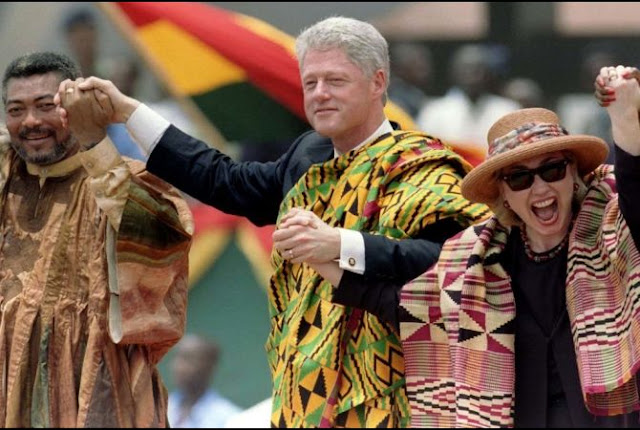
There are gender differences in how the cloth is worn. On average, a man’s size cloth measures 24 strips ( 8 ft. wide) and 12 ft. long. men usually wear one piece wrapped around the body, leaving the right shoulder and hand uncovered, in a toga-like style. Some men wear a jumpa, a kind of collarless shirt over which the cloth is wrapped. Women may wear either one large piece or a combination of two or three pieces of varying sizes ranging from 5-12 strips (20 inches to 48 inches wide) and an average of 6 ft. long.
These are wrapped around the body with or without a matching blouse. In some cases elderly women with high social status may wear a large piece in toga-like fashion just as men do. Within traditional societies, age, marital, and social standing may determine the size and design of cloth an individual would wear. Social changes and modern living have brought about significant changes in how Kente is used.
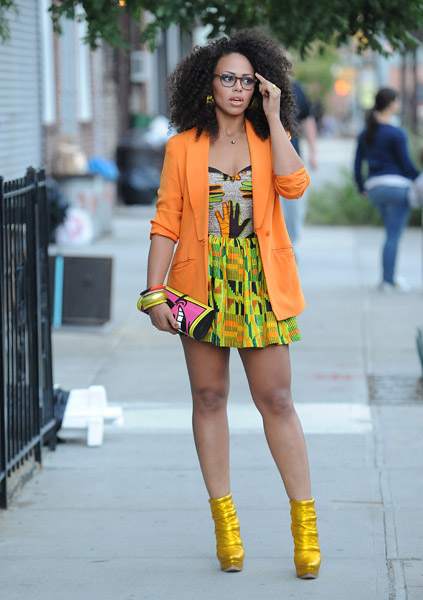
Kente is Used not only for its beauty but also for its symbolic significance. Each cloth has a name and a meaning; and each of the numerous patterns and motifs has a name and a meaning. Names and meanings are derived from historical events, individual achievements, proverbs, philosophical concepts, oral literature, moral values, social code of conduct of conduct, human behavior and certain attributes of plant and animal life.
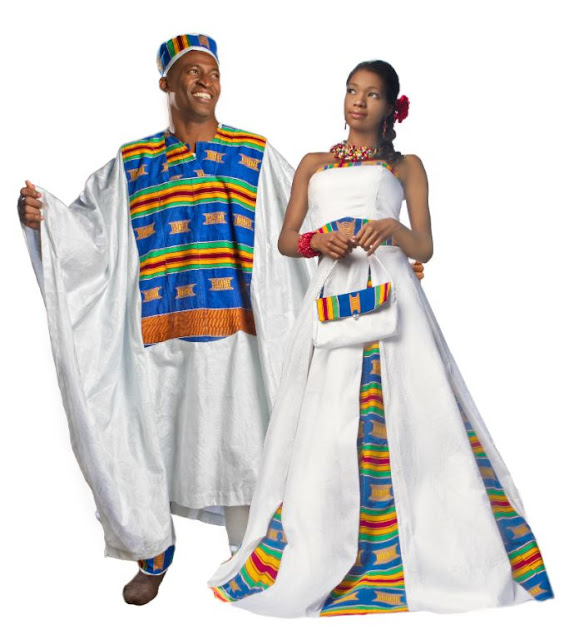
Patterns and motifs are rendered in geometric abstractions of objects associated with the intended meaning. Sometimes. some of such patterns and motifs are arbitrarily determined, and their forms have no direct structural similarities with the concepts or objects symbolized. their relationship is primarily conceptual rather than representational.
Patterns and motifs are generally created by weavers who also assign names and meanings to them. Forms, names and means of such patterns and motifs are sometimes given by weavers who may obtain them through dreams and during contemplative moments when they are said to be in communion with the spiritual world. Sometimes, kings and elders may ascribe names to cloths that they specially commission. Generally, names are based on the warp arrangements of the cloth, however, in some instances, both warp and weft arrangements determine a name of a cloth.
There are over 300 different types of cloth designs, each with its name. Each cloth design comes with numerous variations-in color and distribution of motifs. This chart presents names of 54 different cloth designs, and 42 motifs, their literal meanings and their symbolic significance. Symbolism are given interpretations on the basis of the general Akan culture.
Color symbolism within the Akan culture affects the aesthetics of Kente. Colors are chosen for both their visual effect and their symbolic meanings. A weaver’s choice of colors for both weft and warp designs, may be dictated either by tradition or by individual aesthetic taste. There are gender differences in color preferences, dictated by tradition, individual aesthetic taste and by spirit of the occasion.
As a convention rather than a strict code of dress, women tend to prefer cloths with background or dominant colors that are lighter or tinted, such as white, light yellow, pink, purple, light blue, light green and turquoise. Generally, men tend to prefer cloths with background or dominant colors that are on the shaded side, such as black, dark blue, dark green, maroon, dark yellow, orange and red. Social changes and modern living have, however, led some people to ignore these traditional norms, resulting in color choice based on individual taste.
| Obi Nkye Obi Kwan Mu Si (o-Bee n-che o-Bee k-wahn moo see) The name of this pattern translates into “s ooner or later one could stray into another person’s path.” The meaning of this saying is that nobody is perfect and everybody makes mistakes. If someone happens to get in your way or does something to offend you, it is important to be understanding and to forgive that person. |
|
| Asonawo Ahahamono Emaa Da (ahs-OHN-awoh ah-ahamo-no e-MAH da) This cloth represents “the green snake of the Asona,” one of the seven families.The Asante social system has sev en main families. Each family has its own responsibilities and rights. |
|
| Fathia Fata Nkrumah (Fa-THEA fah-TA n-KROH-mah) The translation for the name of this pattern is “Fathia is a befitting wife for Nkrumah.” Fathia was a charming Egyptian woman who married Nkrumah, the first president of the Republic of Ghana. Their marriage was considered special because it represented the unity of African peoples on the continent. |
|
| Abusua Ye Dom (AH-boo-soo-ah yeh dohm) The name for this pattern means, “the extended family is a force.” This cloth celebrates the extended family and its important role in maintaining the well being of its members. |
YELLOW in all its variations is associated with the yoke of the egg, ripe and edible fruits and vegetables and also with the mineral gold. In some spiritual purification rituals mashed yarn is rendered yellow with oil palm and served with eggs. It symbolizes sanctity, preciousness, royalty, wealth, spirituality, vitality and fertility.
PINK is associated with the female essence of life. It is viewed as red rendered mild and gentle, and therefore associated with tenderness, calmness, pleasantness, and sweetness. According to Akan social thought, these attributes are generally considered as essential aspects of the female essence.
RED is associated with blood, sacrificial rites and the shedding of blood. Red-eyed mood means a sense of seriousness, readiness for a serious spiritual or political encounter. Red is therefore used as a symbol of heightened spiritual and political mood, sacrifice and struggle.
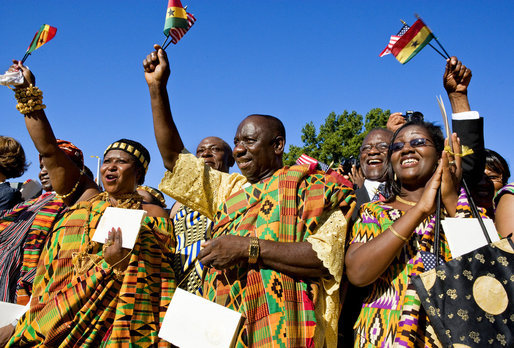
BLUE is associated with the blue sky, the abode of the Supreme Creator. it is therefore used in a variety of ways to symbolize spiritual sanctity, good fortune, peacefulness, harmony and love related ideas.
GREEN is associated with vegetation, planting, harvesting and herbal medicine. Tender green leaves are usually used to sprinkle water during purification rituals. It symbolizes growth, vitality, fertility, prosperity, fruitfulness, abundant health and spiritual rejuvenation.
- READ ALSO: The Nupe Invasion Of Akokoland
PURPLE is viewed in the same way as maroon. It is considered as earth associated with color used in rituals and healing purposes. It is also associated color used in rituals and healing purposes. It is also associated with feminine aspects of life. Purple cloths are mostly worn by females.
MAROON has a close resemblance to red-brown which is associated with the color of Mother Earth. Red-brown is usually obtained from clay and is therefore associated with healing and the power to repel malevolent spirits.
WHITE derives its symbolism from the white part of the egg and from white clay used in spiritual purification, healing, sanctification rites and festive occasions. In some situations it symbolizes contact with ancestral spirits, deities and other spiritual entities such as ghosts. it is used in combination with black, green or yellow to express notion, spirituality, vitality and balance.
GREY derives its symbolism from ash. Ash is used for healing and spiritual cleansing rituals to re-create spiritual balance when spiritual blemish has occurred. It is also used in rituals for protection against malevolent spirits. Grey is therefore associated with spiritual blemish but also with spiritual cleansing.
SILVER is associated with the moon which represents the female essence of life. Silver ornaments are usually worn by women and are used in the context of spiritual purification, naming ceremonies, marriage ceremonies and other community festivals. it symbolizes serenity, purity and joy.
GOLD derives its significance from the commercial value and social prestige associated with the precious mineral. Gold dust and gold nuggets were used as medium of exchange and for making valuable royal ornaments. It symbolizes royalty, wealth, elegance, high status, supreme quality, glory and spiritual purity.
BLACK derives its significance from the notion that new things get darker as they mature; and physical aging comes with spiritual maturity. The Akans blacken most of their ritual objects to increase their spiritual potency. Black symbolizes an intensified spiritual energy, communion with the ancestral spirits, antiquity, spiritual maturity and spiritual potency.
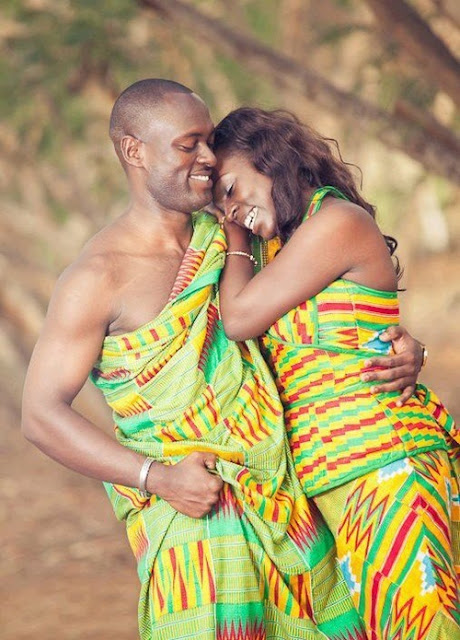
How to Wear Kente Cloth
Kente cloth was traditionally worn by royalty however in modern times they are worn by everyday people for special events such as weddings, naming ceremonies or funerals. Determining what kind of Kente cloth to wear depends on the event as the colors and weave patterns have meanings. First determine the message you would like to send by your choice of color and pattern and make sure it is appropriate for the event. Once you have decided on the cloth, follow these steps to wear it in the traditional manner.
MEN (wrap as you would a Toga if the below is too complicated for you)
- 1. Put yourself in the middle of the kente cloth by holding opposite ends of the cloth in each hand, with the cloth behind you, adjacent to your back.
2. Drape the left end of the cloth over your left shoulder. The extra fabric will end up hanging on the inside.
3. Enfold the fabric from the right side underneath the arm and across the body and place it over your left shoulder.
4. Take the cloth that is covering the left arm and place it over the cloth on the left shoulder so both arms are now exposed and the bulk of the cloth is lying on the left shoulder. (Wrapping is quite similar to a toga style)
WOMEN
1. Wrap the Kente Cloth around the body, underneath the arms (exposing the shoulders) and at waist or breast level. Coordinate with a solid colored blouse. You may also wrap Kente around the shoulders to wear as a shawl.
Nana Acheampong-Tieku appeared in kente cloth and crown after being sworn in as the Ashanti chief of metropolitan New York during the first night of a two-day ceremony in the Bronx last month. Pix: Dave Sanders for The New York Times
Other Beautiful Kente Images
